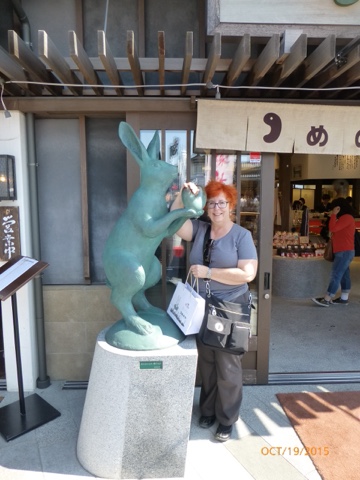After serving us tea she confirmed that our yukatas were correctly sized for our height and had us select a time for dinner in our room. And by the way - our room is huge! And a real bonus is a sitting area with chairs!
We scampered off to the very swanky spa on the top floor for a soak before dinner, returning just as dinner was being delivered.
This style of meal is called kaiseki, which consists of many small dishes. Most of which are fairly mysterious to us. The fish platter looked very good:
And it was - it included bonito tuna that had been seared over a fire made with rice stalks.
Every time we would just about be thinking - okay, that's the lot our lady would pop back with something else until the fruit and ice cream arrived. That we knew was the end! But with the rest of the meal there is no particular order - a little of this, some of that as it catches your fancy. The covered pots hold a little wok filled with pieces of beef, chicken and veggies that cook over a small flame. Off to one side is a similar arrangement to cook the rice.
After we ate the dinner lady took the dishes away and a few minutes later housekeeping arrived to switch us to night mode. The table was moved, futons and bedding retrieved from the cupboard and we were good to go.
Here's what the room looked like with the futons installed.
Through the door at the far end is the entry vestibule with a shoe closet and tea service area. Entry to the toilet and the separate shower/washstand area are from the vestibule. Once the sliding screen is closed we're in a large tatami mat room.
Looking back to the window and the seating area. I kid you not when I say that the vestibule was close to size of some of the rooms we've stayed in.
After a lovely sleep on the thick fluffy futon ( the issue with the futon is getting up and down from the floor, not with the comfort of the bed) I decided to head back up to the spa for another soak - because I could. I trotted upstairs, went down the hall and turned right as I had the night before. I was standing in the entryway about to put my slippers in a cubby hole when a tiny little old lady popped through the curtain and grabbed me. Saying 'no, no' she pushed me through the curtain across the hall and disappeared.
Well, WTF, thought I. I looked at the curtain. Red. In my befuddled state (no coffee) I'm trying to remember - red for ladies blue for men, or other way? As I'm peeking back into the hall a man strolls serenely out the side I had been in.
Oh oh.
So I go into the change room - which is not the one I had been in the night previously. And when I get to the bath area - where the night before the outdoor bath had been a small round jetted tub, now there was a large rectangular pool.
See, this is where it really is annoying to be illiterate. There was a sign in the hall with red writing pointing at the red curtain and blue writing at the blue curtain. A blizzard of kanji, but not a word of English.
I think I have the red is for ladies, blue is for gentlemen rule burned thoroughly into my brain now. And I owe many thanks to the little lady who saved me from really embarrassing myself.
But really- switching from side to side - what's up with that!





















































